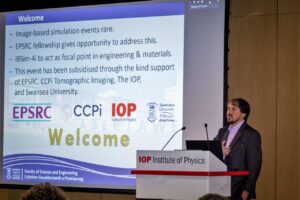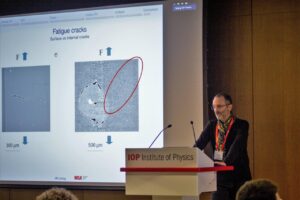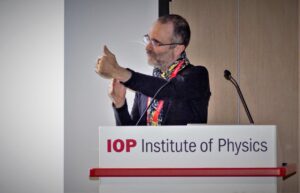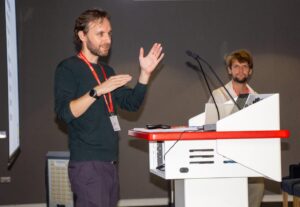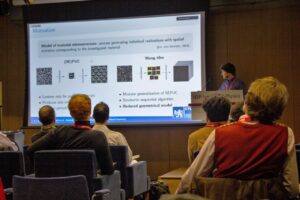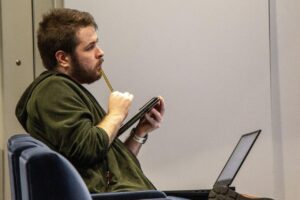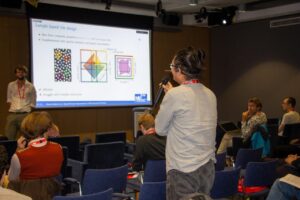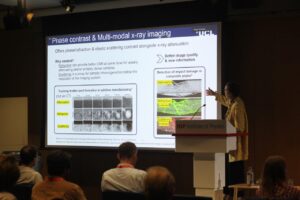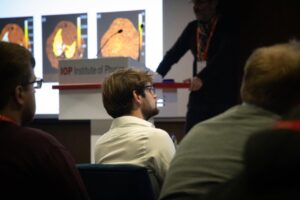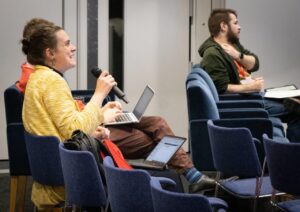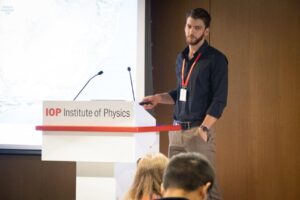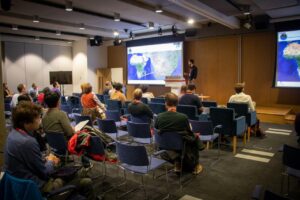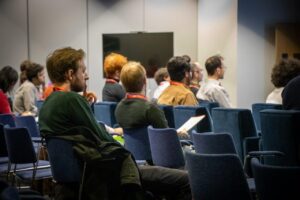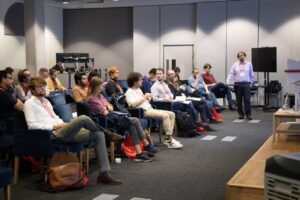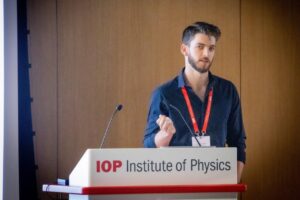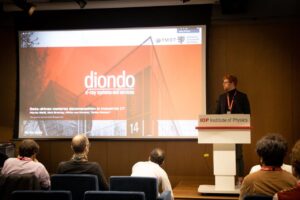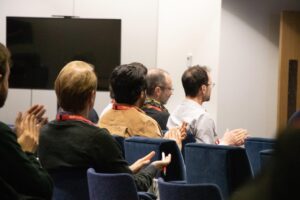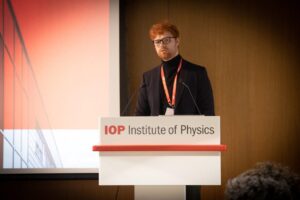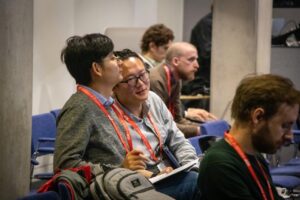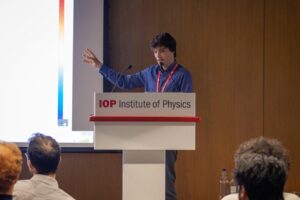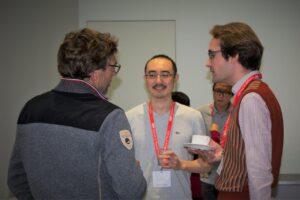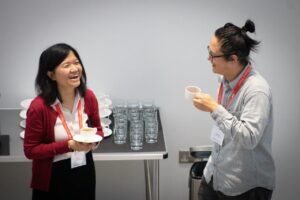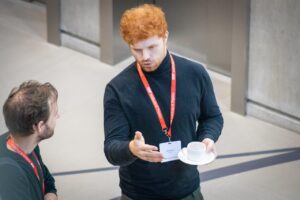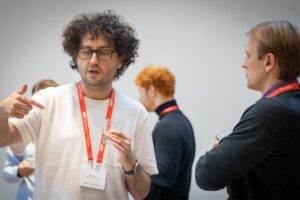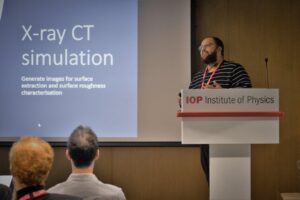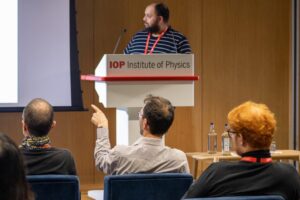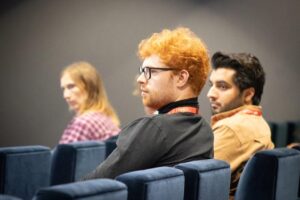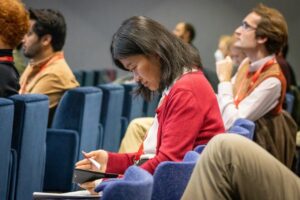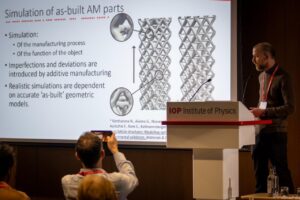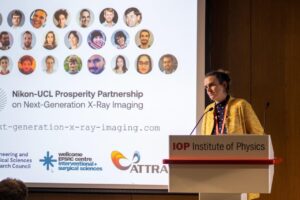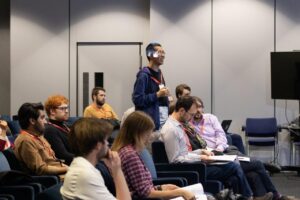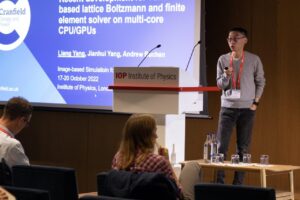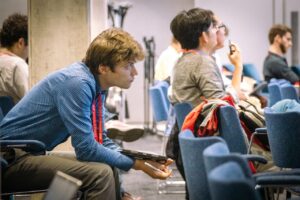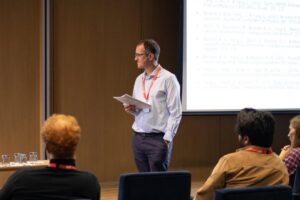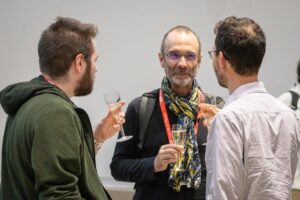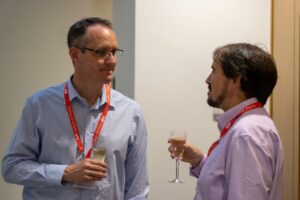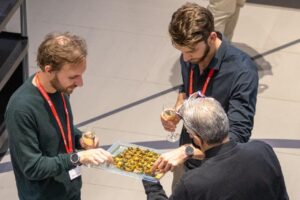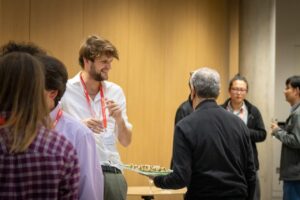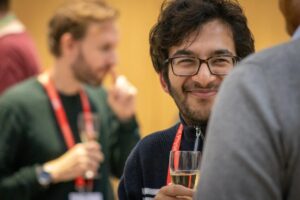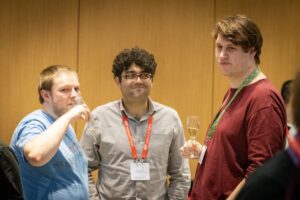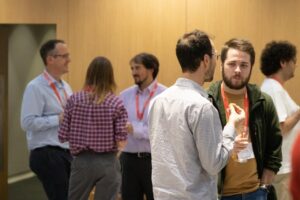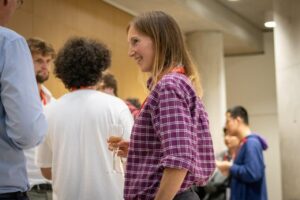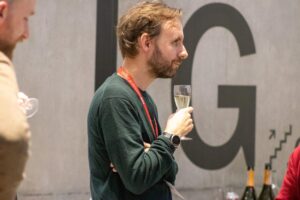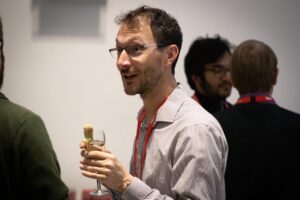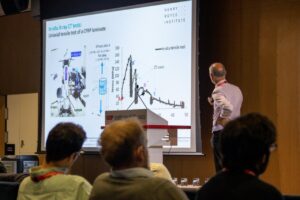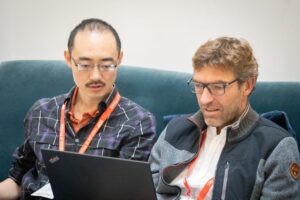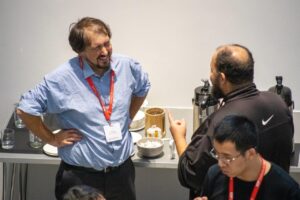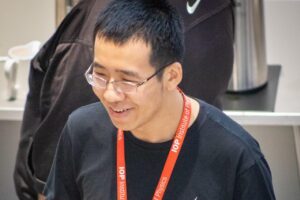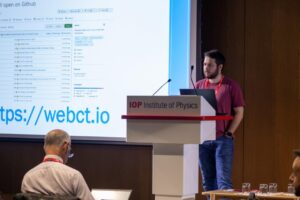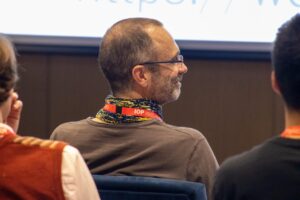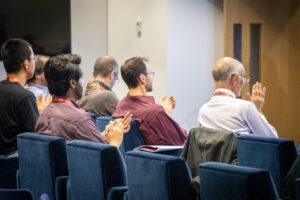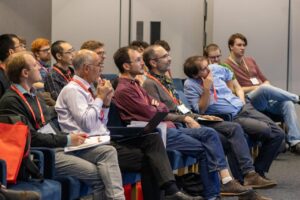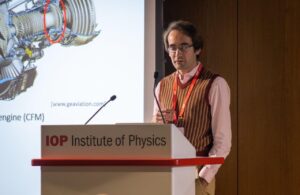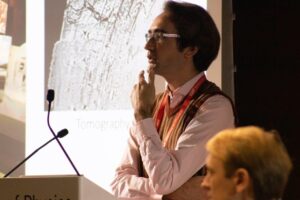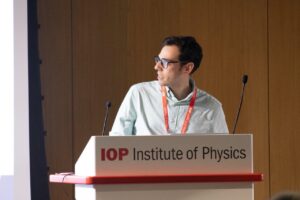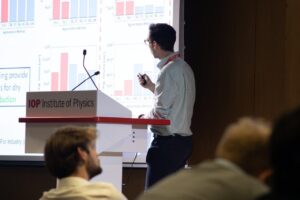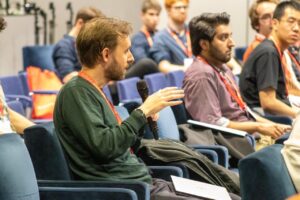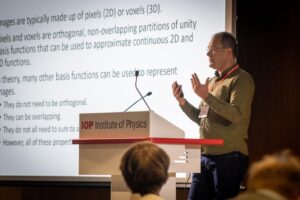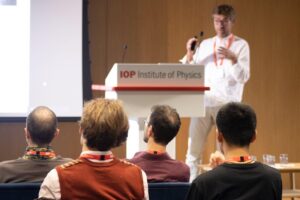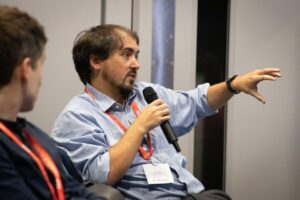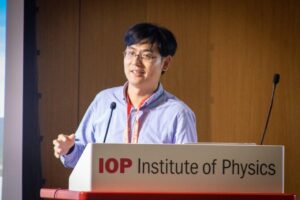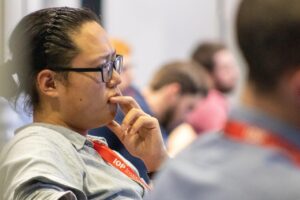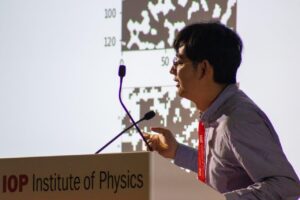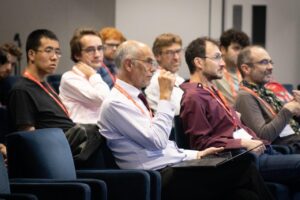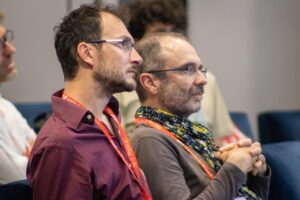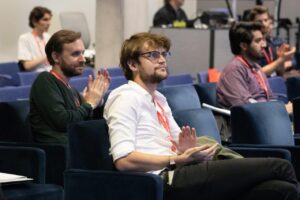Over the four days we had attendees representing academia, research centres, start-up companies and large multinational corporations joining us. Once again, the training course (Day 1-2) was oversubscribed and the forum (Day 3-4) had the largest number of ‘in-person’ attendees since the event launched in 2018. For the second time, the event was hosted by the IOP at their headquarters in London.
Keynote Speakers
Regius Professor Philip Withers, University of Manchester & the Henry Royce Institute for Advanced Materials
CT image-based modelling of composite materials’ failure
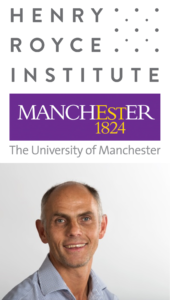 Philip Withers is the first Regius Professor of Materials at the University of Manchester and Chief Scientist of the Henry Royce Institute for Advanced Materials initiated. The Royce brings together the universities of Manchester, Leeds, Sheffield, Oxford, Cambridge, Cranfield, Strathclyde and Imperial College, NNL and UKAEA to support the accelerated design of new materials and a better understanding of existing ones. He has pioneered the use of X-ray CT and electron microscopy to undertake correlative multiscale, multimodal and time-lapse characterisation to follow the behaviour of engineering materials often in 3D and exposed to demanding environments in operando. In 2008 he set up the Henry Moseley X-ray Imaging Facility, one of the most extensive suites of X-ray Imaging facilities in the world with a special focus on in situ time lapse 3D X-ray imaging and now part of a National Research Facility for Lab. X-ray CT. In 2014, the Facility was awarded the Queen’s Anniversary Prize.
Philip Withers is the first Regius Professor of Materials at the University of Manchester and Chief Scientist of the Henry Royce Institute for Advanced Materials initiated. The Royce brings together the universities of Manchester, Leeds, Sheffield, Oxford, Cambridge, Cranfield, Strathclyde and Imperial College, NNL and UKAEA to support the accelerated design of new materials and a better understanding of existing ones. He has pioneered the use of X-ray CT and electron microscopy to undertake correlative multiscale, multimodal and time-lapse characterisation to follow the behaviour of engineering materials often in 3D and exposed to demanding environments in operando. In 2008 he set up the Henry Moseley X-ray Imaging Facility, one of the most extensive suites of X-ray Imaging facilities in the world with a special focus on in situ time lapse 3D X-ray imaging and now part of a National Research Facility for Lab. X-ray CT. In 2014, the Facility was awarded the Queen’s Anniversary Prize.
Dr Jean Michel Létang, CREATIS, INSA, Université de Lyon
Monte Carlo simulations for X-ray imaging: applications in metal fatigue crack characterization
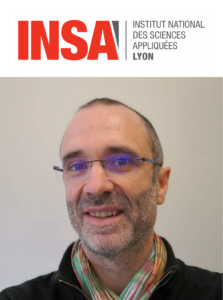 Jean Michel Létang graduated in 1990 from INSA Lyon (electrical engineering dpt) in France. He received his PhD degree in Signal and Image processing from INP Grenoble in 1993. He held several post-doctorate positions in computer vision at INRS-telecom in Montréal (Canada) and at INRIA Grenoble. In 1996 he joined the medical imaging department of Philips Research Laboratories in Paris as a research engineer. Since 1999, he has been an associate professor in nondestructive testing at INSA (mechanical engineering dpt) and conducted his research at the CREATIS medical imaging laboratory. His main research interest in on Monte Carlo simulations for particle transport, and in particular the development of fixed-force detection and variance reduction techniques based the track-length estimator for both imaging and dosimetry. He has been collaborating since 2005 with nuclear physics and instrumentation laboratories for prompt-gamma control in particle therapy. He is also closely involved in reconstruction techniques for tomography, both photons and protons, and in the development of wave modeling for x-ray phase contrast simulations. He has co-supervised more than 20 PhD thesis and co-authored more than 100 papers in international peer-reviewed scientific journals.
Jean Michel Létang graduated in 1990 from INSA Lyon (electrical engineering dpt) in France. He received his PhD degree in Signal and Image processing from INP Grenoble in 1993. He held several post-doctorate positions in computer vision at INRS-telecom in Montréal (Canada) and at INRIA Grenoble. In 1996 he joined the medical imaging department of Philips Research Laboratories in Paris as a research engineer. Since 1999, he has been an associate professor in nondestructive testing at INSA (mechanical engineering dpt) and conducted his research at the CREATIS medical imaging laboratory. His main research interest in on Monte Carlo simulations for particle transport, and in particular the development of fixed-force detection and variance reduction techniques based the track-length estimator for both imaging and dosimetry. He has been collaborating since 2005 with nuclear physics and instrumentation laboratories for prompt-gamma control in particle therapy. He is also closely involved in reconstruction techniques for tomography, both photons and protons, and in the development of wave modeling for x-ray phase contrast simulations. He has co-supervised more than 20 PhD thesis and co-authored more than 100 papers in international peer-reviewed scientific journals.
Additional Speakers
- Byron Blakey-Milner, Aerospace Systems Research Group (ASReG)
- Moritz Weiß, Bergische Universität Wuppertal & diondo
- Mario Sandoval, University Of Manchester
- Fatih Uzun, University Of Oxford
- Xiangyun Ge, Swansea University
- Oliver King, Diamond Light Source Ltd
- Martin Doškář, Czech Technical University in Prague
- Amin Garbout, University Of Manchester & NXCT
- Oliver Barrowclough, SINTEF
- Grammatiki Lioliou, University College London
- Liang Yang, Cranfield University
- Elena Syerko, Nantes Université, École Centrale de Nantes
- Iwan Mitchell, Bangor University
- Léonard Turpin, Université Paris-Saclay
- Pedro Galvez-Hernandez, University of Bristol
- Thomas Blumensath, µ-VIS X-ray Imaging Centre, The University of Southampton
- Lionel Gélébart, Université Paris-Saclay
- Shan Zhong, Swansea University
- Tamsin Dobson, University of Bristol
- James Le Houx, Diamond Light Source
- Artem Lunev, ITMO University
Programme
The slides from the presentations delivered during the forum (days 3-4) have kindly been made available to download by many of the authors. Navigate below to the day and session on which the presentation was given and click on the title to download (more will be added as they become available).
Mon Oct 2022
Hands-on training with gVirtualXRay (gVXR) for simulating virtual XCT scans.
- 9:30 – Registration & Coffee
- 10:00 – Session 1
gVXR: Introduction to X-ray attenuation and its implementation in gVXR - 11:00 – Session 2
- gVXR: First X-ray radiograph simulations
- Monochromatic spectrum
- Multi-material samples
- 12:30 – Lunch
- 13:30 – Session 3
- gVXR: More advanced simulations
- Polychromatic spectrum
- Photonic noise
- Source shape (e.g. parallel vs cone beam)
- Focal spot
- 14:45 – Coffee
- 15:15 – Session 4
- gVXR: Simulation of tomography acquisition
- 17:00 – End
Tue Oct 2022
Hands-on training for the Core Imaging Library (CIL), an open-source reconstruction platform for challenging and novel data.
- 9:00 – Session 5
CIL: Introduction to XCT and the CIL framework for reconstruction of commercial lab-based XCT data with FBP/FDK - 10:30 – Coffee
- 11:00 – Session 6
- CIL: Pre-processing of XCT data, e.g., centre of rotation correction
- 12:30 – Lunch
- 13:30 – Session 7
- CIL: Iterative reconstruction methods for standard XCT data
- 14:45 – Coffee
- 15:15 – Session 8
- CIL: (choose one of)
- Reconstruction of data simulated from gVXR
- Advanced iterative reconstruction with spectral XCT data
- Advanced iterative reconstruction on laminography XCT data
- 17:00 – End
Wed Oct 2022
- 9:30 – Registration & Coffee
- 10:00 – Welcome
- 10:15 – Keynote 1
Jean Michel Létang, CREATIS, INSA, Université de Lyon
“Monte Carlo simulations for X-ray imaging: applications in metal fatigue crack characterization” - 11:00 – Session 1
Byron Blakey-Milner, Aerospace Systems Research Group (ASReG)
“Image-based simulation techniques for AM-built rocket engine components“
Moritz Weiß, Bergische Universität Wuppertal & diondo
“Data-driven material decomposition in industrial CT”Mario Sandoval, University Of Manchester
“Multiple DOF for X-ray CT Hydrocarbon Exploration“ - 12:15 – Lunch
- 13:15 – Session 2
Fatih Uzun, University Of Oxford
“3D Reconstruction of Residual Stresses in Bodies Manufactured by Laser Powder Bed Fusion Using the Strain Tomography Technique”
Xiangyun Ge, Swansea University
“Microstructure reconstruction of porous media via sequence prediction for computational material design”
Oliver King, Diamond Light Source Ltd
“SuRVoS2 – An open-source application to accelerate annotation and segmentation of 3D image data using supervoxels and machine learning“Martin Doškář, Czech Technical University in Prague
“Beyond Periodic Representation of Microstructural Geometry“ - 14:55 – Coffee
- 15:25 – Session 3
Amin Garbout, University Of Manchester & NXCT
“Generation of images for surface extraction and surface roughness characterisation using virtual X-ray CT scanning and Machine Learning“
Oliver Barrowclough, SINTEF
“Data-driven techniques for creating digital twins in additive manufacturing”Charlotte Hagen, University College London
“Novel X-ray CT flyscan trajectories and their potential for industrial applications“Liang Yang, Cranfield University
“Recent development for voxel-based lattice Boltzmann and finite element solver on multi-core CPU/GPUs“ - 17:05 – End
- 17:30 – 21:00 – Networking Reception
Thu Oct 2022
- 9:30 – Keynote 2
Philip Withers, University of Manchester & the Henry Royce Institute for Advanced Materials
“CT image-based modelling of composite materials’ failure” - 10:15 – Session 4a
Elena Syerko, Nantes Université, Ecole Centrale de Nantes
“Micro-Scale Results from the Benchmark Exercise on the Image-Based Permeability Prediction of Composite Reinforcements“ - 10:40 – Coffee
- 11:10 – Session 4b
Iwan Mitchell, Bangor University
“WebCT: Fully Featured Browser-Based Interactive X-Ray Simulations for Scan Planning and Training“
Léonard Turpin, Université Paris-Saclay
“Identification of the parameters of an image-based model using integrated digital volume correlation“Pedro Galvez-Hernandez, University of Bristol
“Phase segmentation of uncured composite prepregs via deep learning“ - 12:25 – Lunch
- 13:25 – Session 5
Thomas Blumensath, µ-VIS X-ray Imaging Centre, The University of Southampton
“X-ray Tomographic Reconstruction using Adaptive Mesh Representations“
Lionel Gélébart, Université Paris-Saclay
“AMITEX_FFTP – A massively parallel FFT code for Image-Based mechanical simulation of heterogeneous materials“Shan Zhong, Swansea University
“A deep learning stochastic reconstruction method with Hilbert curves” - 14:40 – Coffee
- 15:10 – Session 6
Tamsin Dobson, University of Bristol
“Imaged Based Simulation of Weld Toes and Corrosion Pits in Plasma Welded Nickel Aluminium Bronze (NAB)”
James Le Houx, Diamond Light Source
“Statistical Analysis of Effective Diffusivity Estimations in Porous Media”
Artem Lunev, ITMO University
“When simple models fail: CT-FEA simulations of metal foams“ - 16:25 – Wrap up
- 16:40 – Close
Fri Oct 2022
Optional day for stakeholders and additional interested parties for a progress update on the EPSRC funded project “Inline virtual qualification from 3D X-ray imaging for high-value manufacturing” and workshop to plan future collaborative research projects.
- 9:00 – Coffee
- 9:30 – Session 1: IBSim Dissemination
- 10:45 – Coffee
- 11:15 – Session 2: IBSim Benchmarking & Case Studies
- 12:30 – Lunch
- 13:30 – Session 3: IBSim Workflows for Industry
- 14:45 – Coffee
- 15:15 – Session 4: Status Report & Future Opportunities
- 16:30 – Close
Recordings [Day 3]

